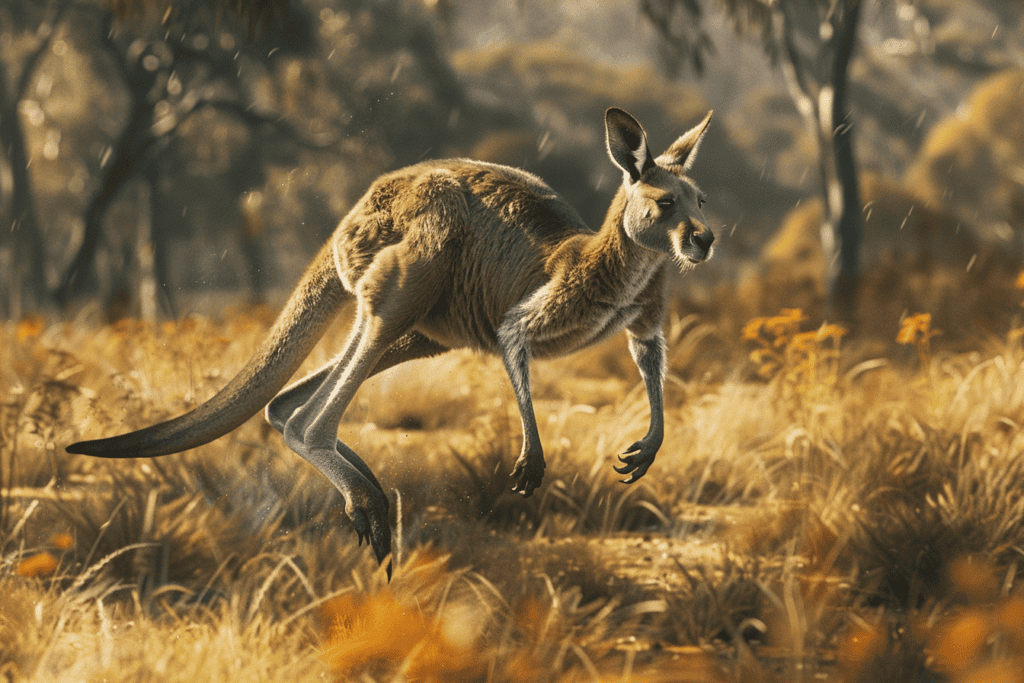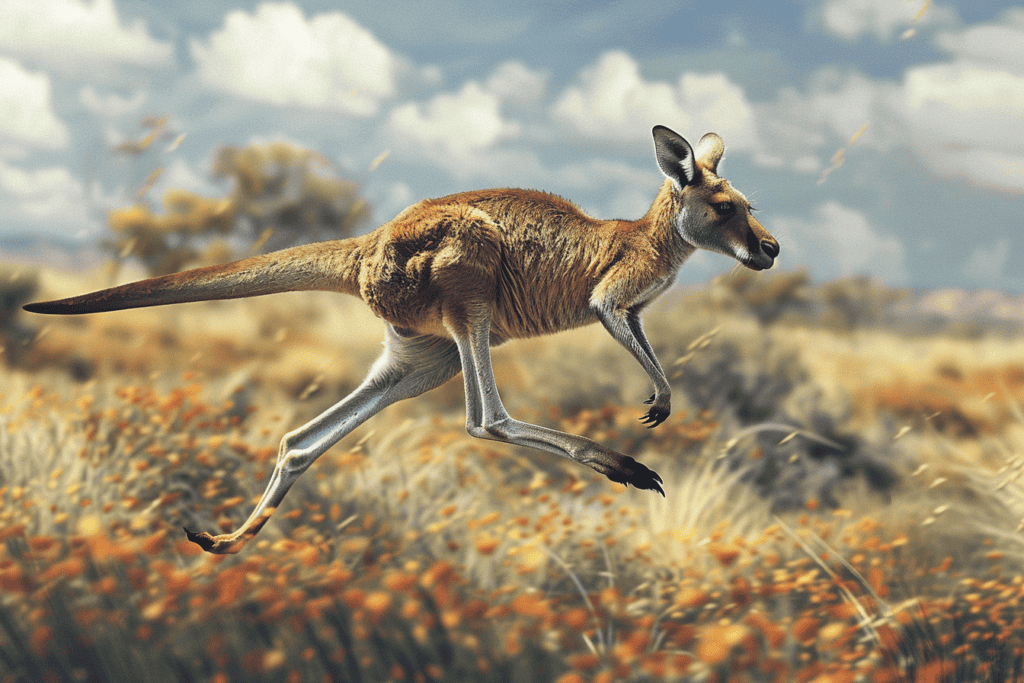Kangaroos are incredible athletes, thanks to their powerful hind legs and long, spring-like tendons.
They can leap 25 feet in a single bound and reach speeds of up to 35 miles per hour. Their unique hip structure and flexible spine store and release energy efficiently, allowing them to traverse the vast Australian outback without tiring quickly.
Their strong tails act as counterbalances, aiding in sharp turns and sudden stops, even enabling jumps with 180-degree turns. This agility helps them evade predators and survive harsh environments.
What Makes The Anatomy of a Kangaroo Special?

A kangaroo’s powerful hind legs and long, muscular tail are key to its incredible speed and agility.
These unique characteristics make kangaroos fascinating creatures to observe.
When you look at a kangaroo, you’ll notice its hind legs aren’t just long but incredibly strong.
These legs are designed to generate enormous force, allowing the kangaroo to cover great distances with each hop.
This unique hopping ability is a marvel of nature, helping kangaroos reach speeds of up to 35 miles per hour!
But it’s not just the legs that make a kangaroo special.
The tail, often overlooked, plays a vital role in its movement.
Acting almost like a fifth limb, the strong tail provides balance and stability.
When a kangaroo is hopping, the tail helps in steering and maintaining an upright posture.
During slower movements, such as walking on all fours, the tail supports the body, making it easier to maneuver.
Together, the powerful hind legs and strong tail give the kangaroo its distinctive edge.
These features aren’t just for show; they’re essential for survival in the wild, enabling kangaroos to escape predators and cover vast terrains in search of food.
Mechanics of Hopping

When you observe a kangaroo in motion, you’ll see how the mechanics of hopping enable these animals to move with remarkable speed and efficiency.
Kangaroos use their strong hind legs, flexible spine, and elastic tendons to achieve incredible speed and agility. Each single hop can cover up to 25 feet, propelling them forward at speeds of up to 30 miles per hour.
Their unique hip structure and spine work together to store and release energy with each hop, making this mode of locomotion highly energy-efficient. This energy-efficient method allows kangaroos to conserve strength while traveling long distances or escaping predators.
The strong tail acts as a counterbalance, providing stability and aiding in sharp turns and sudden stops.
The speed and agility of kangaroos are truly impressive. They can perform quick, sharp turns, and even complete a 180-degree turn in a single hop.
This vital ability is essential for survival in the wild, enabling them to navigate the rugged Australian outback with ease. By understanding the mechanics of hopping, you can appreciate how these fascinating creatures have adapted to thrive in their environment.
Kangaroos Are Fast And Can Travel Long Distances

Understanding the mechanics of hopping allows us to better appreciate the impressive speed and distance kangaroos can cover.
These remarkable creatures, native to the vast Australian landscape, have evolved a unique form of locomotion that sets them apart from other animals.
When a kangaroo hops, it can reach speeds of up to 35 miles per hour, a demonstration of their speed and efficiency.
This form of movement isn’t just fast; it’s also incredibly efficient.
Kangaroos use less energy compared to other large animals when traveling long distances.
Their powerful hind legs and elastic tendons act like natural springs, storing and releasing energy with each hop.
This means they can cover extensive areas without tiring quickly, allowing them to traverse the vast Australian outback with ease.
Imagine a kangaroo effortlessly bounding across the terrain, each leap propelling it farther and faster than you might expect.
Moreover, their hopping isn’t just about speed but also about covering impressive distances.
A single hop can cover up to 25 feet in length and reach heights of 6 feet, making kangaroos one of the most efficient and agile creatures in the animal kingdom.
Kangaroos Are Energy Efficient

Kangaroos have mastered energy efficiency by storing and releasing elastic energy in their tendons with each hop.
They use their powerful leg muscles to compress their tendons and ligaments, which act like springs. When they hop, these tendons release the stored energy, propelling them forward with incredible efficiency.
This unique mechanism allows kangaroos to cover impressive distances—up to 25 feet in a single bound—while using less energy than walking or running would require.
In the harsh environments of the Australian outback, where food and water can be scarce, this energy efficiency is vital. It enables kangaroos to travel long distances in search of sustenance without exhausting themselves, which is essential for their survival.
Predators and Survival

Speed and agility are essential for kangaroos to evade predators in the wild.
In the world of kangaroos, these remarkable animals have developed unique physical adaptations to survive. Their strong hips and a slim, flexible upper body allow them to make sharp turns, often achieving a 180-degree turn in a single hop. This agility is pivotal when faced with predators like dingoes and eagles.
Kangaroos’ ability to hop at speeds of up to 45 miles per hour gives them a significant advantage. When disturbed, they can bound away quickly, using their speed to put distance between themselves and the threat. This rapid hopping not only conserves energy but also reduces stress on their legs, ankles, and feet, making it an efficient escape tactic.
In addition to speed, kangaroos have developed powerful legs to kick, a formidable defense mechanism against predators. A well-placed kick can deter would-be attackers, ensuring the kangaroo’s survival. Different species of kangaroos, from the red kangaroo to the eastern grey, utilize these skills to navigate their often perilous environments.
Conservation Efforts

Recognizing the urgent need to protect these agile wonders, conservation efforts have become more critical than ever. Kangaroos, with their incredible speed and agility, have captured the hearts of people worldwide.
The International Union for Conservation of Nature (IUCN) plays a pivotal role in these efforts. By categorizing different species of kangaroos based on their conservation status, the IUCN helps prioritize which species need immediate attention.
You mightn’t realize it, but several species of kangaroos face threats from habitat destruction, climate change, and human activities. The Union for Conservation works tirelessly to address these challenges.
They collaborate with local communities, governments, and international organizations to implement effective strategies. These include habitat restoration, anti-poaching initiatives, and public awareness campaigns.
You can also play a part in these conservation efforts. Supporting organizations dedicated to wildlife preservation, reducing your carbon footprint, and spreading awareness about the plight of kangaroos can make a significant difference.
Every action counts when it comes to preserving the natural habitats of these extraordinary animals. By working together, we can safeguard that future generations will continue to marvel at the speed and agility of kangaroos in the wild.
Frequently Asked Questions
How Do Kangaroos Raise and Care for Their Young?
You’ll see kangaroos raise their young through pouch development, ensuring joey nutrition and strong maternal bonding. They employ survival strategies like embryonic diapause, delaying birth until conditions are right, enhancing their offspring’s chances of survival.
What Role Do Kangaroos Play in Indigenous Australian Culture?
You’ll find that kangaroos hold deep spiritual significance in indigenous Australian culture. They feature prominently in Dreamtime stories, tribal symbolism, and hunting practices, reflecting their integral role in the connection to the land and ancestors.
Are There Any Famous Kangaroos in Popular Media or Folklore?
You’ll find famous kangaroos in popular media like Skippy Roo from ‘Skippy the Bush Kangaroo’, the Boxing Kangaroo, Kangaroo Jack from the 2003 film, and Roo from Disney’s ‘Winnie the Pooh’. They’ve all made impactful appearances.
How Do Kangaroos Communicate With Each Other?
You’ll find kangaroos communicate using thumping signals, vocal calls, tail movements, and grooming habits. They thump the ground for danger alerts, use vocal calls for social interaction, and groom each other to strengthen bonds.
What Are the Different Species of Kangaroos and Their Unique Characteristics?
You’ll find four main kangaroo species: Red, Eastern Grey, Western Grey, and Antilopine. Each has unique physical traits and habitats, distinct feeding habits, and varying conservation efforts to protect their populations in the wild.









